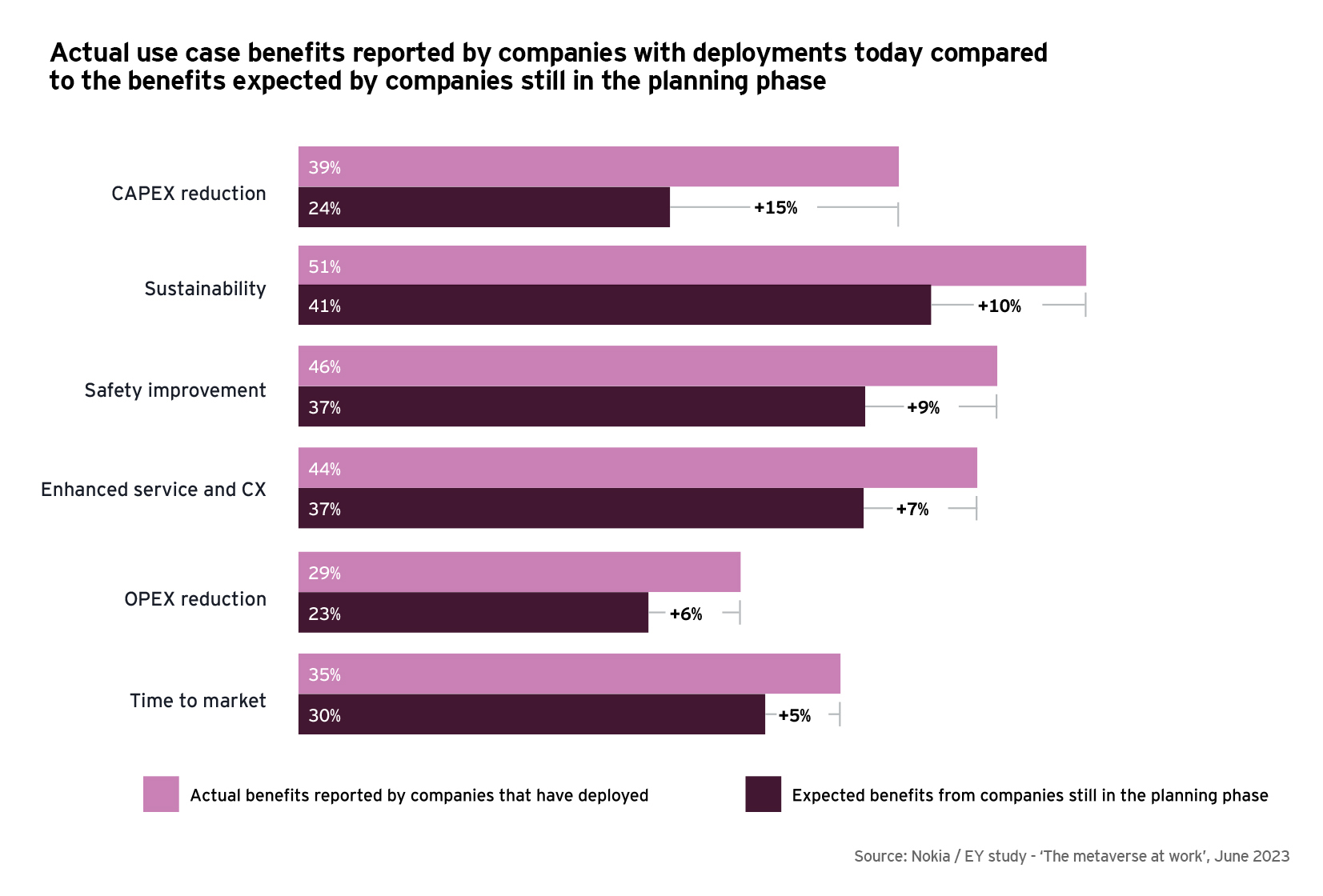Metaverse Slowly Gets Real
New Nokia, Ernst & Young (EY) study finds metaverse potential for predictive maintenance, autonomous operations, and virtual prototyping and testing applications.

Nokia and EY study finds industrial metaverse delivering benefits for CAPEX reduction, sustainability, and safety improvements. Image Courtesy of Nokia and EY
Latest News
June 19, 2023
To many, the metaverse is no different than an over-hyped video game. To others, it’s entrée into a next-generation digital world that will upend how companies design, produce, and support products.
According to a new survey conducted by Nokia and Ernst & Young (EY), the metaverse remains a little bit of both. The survey, of 356 industrial goods and manufacturing leaders, found early metaverse adopters in the industrial space generally happy with outcomes from initial use cases with only a fraction (2%) of respondents chalking up the metaverse to be a fad or irrelevant buzzword. About 60% of those surveyed have already piloted or deployed a use case, and among the 40% who have not yet taken the plunge, almost all (98%) say they plan to leverage some form of the metaverse over the next 2 years.
Predictive maintenance was one of the most-cited industrial applications for the metaverse, with companies interested in using digital twins—specifically, virtual representations of real-world assets—to better understand asset health and to enable more predictive design making. Nearly a quarter (23%) planned to experiment with a metaverse-enabled predictive maintenance application, most anticipating such benefits as process efficiency (48%), sustainability (40%), and accelerated time to market (40%).
Another quarter of respondents are expecting to leverage metaverse capabilities for autonomous and remote-controlled operations robotics. These capabilities are intended to allow remote operations through an on-site robot for inspection and audit purposes, with the metaverse allowing for human oversight and intervention. Anticipated key benefits in this domain include process efficiencies (48%), safety improvements (40%), and sustainability (40%).
The third most anticipated industrial use case for metaverse capabilities is for virtual prototyping and testing. Companies see potential for allowing design and engineering professionals to collaborate, leveraging metaverse capabilities to enable better cross-functional collaboration and co-design outcomes. By conducting such functions in a digitally-augmented world, enterprises expect to improve time-to-market for product delivery while also reducing the number of setbacks and waste prior to official product launches.
Across the early use cases, the survey found early metaverse adopters reporting benefits more often than companies still in the planning phase, with CAPEX reduction (15%), sustainability (10%), and safety (9%) at the forefront of advantages they’re experiencing.
Companies experimenting with metaverse use cases have identified an array of required foundational technology enablers. Cloud computing (72%); AI/ML (70%); and network connectivity, including private 5G/6G (70%), fiber broadband (68%), as well as public 5G/6G (67%), are seen as the most important technical enablers to power metaverse use cases, according to the survey. Other significant hardware investments will include smart sensors, IoT devices and networks, and positioning and location systems.
Despite the progress, there are numerous challenges slowing adoption of metaverse technologies for industrial applications. Lack of internal expertise is the biggest obstacle, cited by 47% of survey respondents, followed by technical difficulties (39%) and over budget issues (32%). The survey identified some skepticism and mistrust associated with the metaverse, much of it due to pre-existing notions about its close connection to online gaming.
To overcome such misconceptions and encourage employee adoption, organizations should focus on education and on investing in the enabling technologies required to pilot and scale metaverse solutions. This is especially important for companies in the industrial goods and manufacturing space as self-reported maturity with enabling technologies is low compared to other industries, the report found. At the same time, the research shows it may take time to get data capture technology and connectivity to a level sufficient to scale use cases.
“This study shows the clear appetite for these technologies such as extended reality and digital twins to achieve business goals,” said Vincent Douin, executive director, Business Consulting and Business Transformation, at Ernst & Young. “We are already seeing many organizations going above and beyond the planning stages and recognizing tangible benefits from their initial implementations.”
For a deep dive on how industrial companies are currently and are planning to put the metaverse to work, tune into this comprehensive report from The Economist.
Subscribe to our FREE magazine, FREE email newsletters or both!
Latest News
About the Author
Beth Stackpole is a contributing editor to Digital Engineering. Send e-mail about this article to DE-Editors@digitaleng.news.
Follow DE





